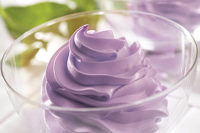Formulating natural colors in dairy foods
Consumer awareness of natural colorings in dairy foods is important. But coloring milk and dairy foods is a tricky proposition. Never fear. We look at red, yellow, blue and green color options for milk, cheese, yogurt and ice cream.










Label-friendly with benefits
That role may be even more critical in the dairy category, where even indulgences like ice cream and milkshakes can convey a healthful aura. According to Jody Renner-Nantz, global applications scientist, D.D. Williamson, Louisville, Ky., “A lot of nutrition studies are coming out about the benefits of dairy.” The buzz on everything from probiotics to chocolate milk as a recovery beverage has landed the category in a good-for-you spotlight. As a result, she said, “I think it’s natural to couple those benefits with good-for-you ingredients like naturally derived colors.”
In some cases, the right colorant can even brighten dairy’s health halo. Consider that the body converts beta carotene — a familiar exempt colorant — to vitamin A. As Todd Katz, food and beverage applications lab manager, DSM Nutritional Products, Parsippany, N.J., pointed out, 1 milligram of beta carotene delivers 1,667 IUs (International Units) of vitamin A activity.
“When used for coloration, a product may need up to 10 milligrams per liter of beta carotene crystal. In a beverage with a standard 240-milliliter serving size, this would deliver 4,000 IUs, or 80% of the daily value.” Importantly, Katz noted, beta carotene must appear on the label as either a colorant or the nutrient pro-vitamin A, but not both.
Choosing the most label-friendly ingredient might be the easiest part of the process; milk is a finicky medium to color. Everything, from the background shade to inherent chemistry, complicates the coloring challenge.
First of all, Renner-Nantz said, “Milk, obviously, is white. And that tends to flush out the color.” Her general solution is to “overdose a little on the color” when overcoming a white background or, as in the case of caramel, which tends to appear grayish in dairy beverages, to “combine different colors — maybe a caramel with a lycopene — to give more of a red hue in a chocolate product, to give it more depth.”
Then there’s the issue of the dairy matrix itself. Chad Ford, product manager of colors, Wild Flavors Inc., Erlanger, Ky., said, “It can be difficult to apply coloring to an application with a high fat content or one that requires high-heat processing.” UHT treatment in particular is especially damaging to exempt colors.
And even if dairy’s refrigerated storage can prolong colorant life, it may also let formulators add more “stuff” to the product mix.
“A refrigerated product has more actives going on inside,” said Rodger Jonas, director of national sales, P.L. Thomas Inc., Morristown, N.J. “There could be probiotics, functional ingredients — there’s a lot more variability going on. There are a lot more things interacting with the colorant.”
Looking for a reprint of this article?
From high-res PDFs to custom plaques, order your copy today!











